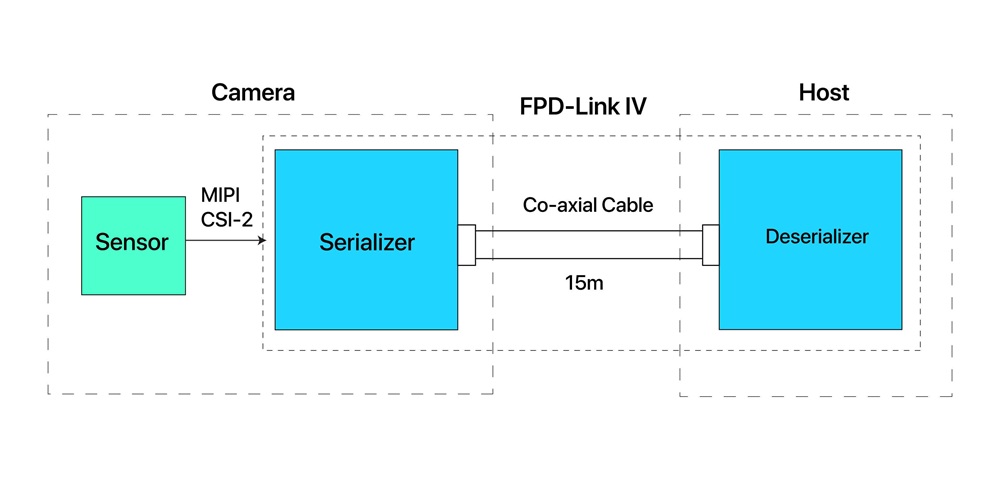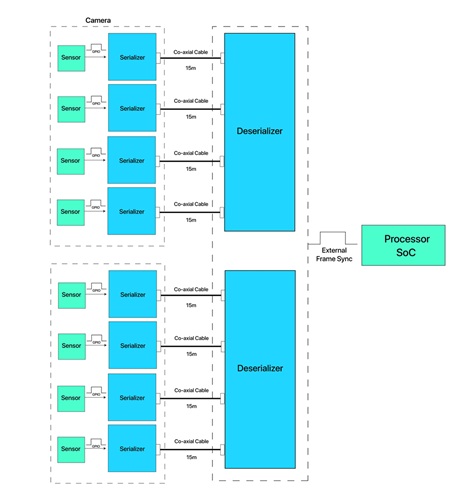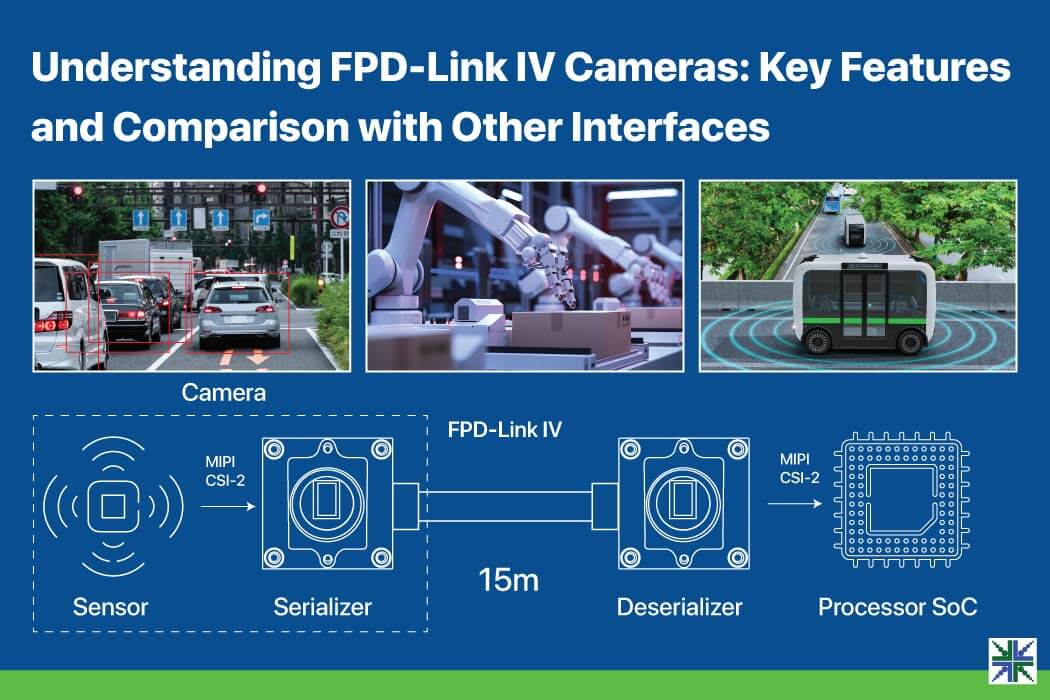What You’ll Discover in This Blog:
- A deep dive into the technology behind FPD-Link IV
- Key Advantages of using FPD-Link IV-based camera systems in embedded applications
- A clear comparison between FPD-Link IV and other Interfaces
Cameras have accelerated the evolution of embedded applications such as ADAS, intelligent traffic systems, smart checkout systems, infotainment systems, and rear-view systems by enabling real-time video processing. However, long-range, low-latency video transmission and electromagnetic interference (EMI) remain a major challenge. The reason? High-resolution video demands greater data capacity and accurate synchronization.
FPD-Link IV interface, developed by Texas Instruments, addresses these challenges. It allows cameras to transmit high-definition, real-time video over long distances with low latency and multi-camera synchronization using a single coaxial or STP cable.
In this blog, we’ll see how these FPD-Link IV-based cameras work and highlight the key advantages of using FPD-Link IV-based camera systems in embedded applications.
What is an FPD-Link IV Camera?
FPD-Link IV-based camera utilizes an FPD-Link IV interface developed by Texas Instruments, incorporating Serializer/Deserializer (SerDes) technology to deliver high-definition video in real-time over long distances with low latency. These cameras utilize a bidirectional communication channel, transmitting video as well as control signals (I2C/GPIO) and power (PoC) over a single, lightweight coaxial or shielded twisted pair (STP) cable.
The camera has an FPD-Link IV serializer and companion FPD-Link deserializer. It integrates seamlessly with popular processing platforms, including NVIDIA Jetson and Texas Instruments SK-TDA4VM, making it ideal for advanced use cases such as ADAS and surround-view systems.
The block diagram of the FPD-Link IV-based camera is shown in the figure below.

Figure 1: Block Diagram of FPD-Link IV-Based Camera
Depending on the particular chipset and implementation, some FPD-Link IV serializers and deserializers can work backwards with FPD-Link III devices.
Now that you have learnt about the FPD-Link IV-Based camera, let us see how it works in the following sections.
FPD-Link IV Cameras Compared to Other Camera Interfaces: A Technical Overview
FPD-Link-based cameras can be installed up to 15 meters away from the processing unit (ECU or SoC), offering a clear advantage in range in a typical automotive setup.
FPD-Link offers an advantage with its serializer-deserializer (SerDes) technology, enabling high-speed data transmission over a single coaxial or STP cable across significantly longer distances.
In comparison, USB 2.0 cameras, USB 3.0 cameras, MIPI cameras, GMSL cameras, and GigE cameras each provide their own benefits but are constrained by certain limitations. MIPI excels at high-speed transmission over short distances (typically within 30 cm), whereas USB cameras can support transmission up to 3-5 meters. GigE cameras are best for long-range (up to 100m) but may add milliseconds of latency compared to point-to-point interfaces like FPD-Link, whereas GMSL3 cameras can be placed 14 meters away from the host processor.
FPD-Link IV, however, offers an advantage with its serializer-deserializer (SerDes) technology, enabling high-speed data transfer over a single coaxial or STP cable across much longer distances.
The FPD-Link IV camera with MIPI CSI-2 interface sends MIPI CSI-2 data to the FPD-Link IV serializer and control signals using I2C/GPIO signals. The serializer receives CSI-2 video from the sensor, where the D-PHY interface uses a clock lane and up to four data lanes, each supporting speeds from 80 Mbps to 1.5 Gbps.
The deserializer converts the FPD-Link data received from the serializer to the MIPI data. It sends it to the processing unit (ECU or SoC) through an EMI-shielded coaxial or STP cable.
Now, let’s quickly compare the features between FPD-Link IV interfaces and other interfaces.
FPD-Link III vs. FPD-Link IV
The following comparison tables break down the key differences between FPD-Link III, FPD-Link IV, and GMSL3, making it easier to evaluate bandwidth, resolution, latency, and feature support side-by-side.
| Feature | FPD-Link III Interface | FPD-Link IV Interface |
| Single-Port Bandwidth | 4.16 Gbps | 7.55 Gbps |
| Maximum Resolution & Frame Rate | 1080p @ 60 FPS | 4k @ 45 FPS |
| Power Consumption | 280 mW | 425 mW |
| Per Lane Speed | 832 Mbps/lane | 1.5 Gbps/lane |
| Virtual Channel Support | 4 Virtual Channels (VCs) | 16 Virtual Channels (VCs) |
| Functional Safety Compliance | Yes | Yes |
| AEC-Q100 Qualified | Yes | Yes |
| PoC (Power over Coax) Compatible Transceiver | Yes | Yes |
FPD-Link IV Vs GMSL3
| Feature/parameter | FPD-Link IV | GMSL3 |
| Backward Interface | I2C | I2C & UART |
| Forward Interface | 4 lane MIPI CSI 2 | MIPI & Parallel interface |
| Package Size | 5mm x 5mm | 5mm x 5mm |
| Operating Temperature | –40°C to +115°C | –40°C to +125°C |
| Bandwidth for FC & BC | 7.55 Gbps & 47.1875 Mbps | 12Gbps & 187.5Mbps |
| GPIO supported | 4 | 10 |
| Synchronization | Possible | Possible |
| Max. Cable length | 15m | 14m |
| AEC-Q100 Qualified | yes | yes |
| Functional safety complaint | yes | yes |
Key Technical Advantages of FPD-Link IV-Based Cameras
Automotive-grade camera design
The camera must use automotive electronics to qualify as an automotive-grade camera, which can withstand harsh operating conditions. The enclosure must also pass compliance tests for extreme temperatures, typically ranging from -40°C to 85°C, and achieve a rating such as IP69K to ensure protection against dust and high-pressure water jets.
Additionally, such cameras are generally required to comply with FCC and CE standards for electromagnetic interference and safety. Automotive-grade cameras operate reliably under rugged, outdoor, or industrial conditions, such as fleet management systems and mining vehicles.
External trigger support
FPD-Link IV-based cameras support external triggering through bidirectional communication, enabling precise control signals to be sent from the host to the camera. So, the camera can initiate image capture based on specific events or timing requirements. It is especially useful for synchronizing multiple cameras.
See the block diagram of the external trigger below:

Figure 2: External Trigger Support
Multi-camera synchronization
The multi-camera systems rely heavily on multi-camera synchronization for visual perception, object detection, and localization. The FPD-Link IV-based camera supports up to four cameras with Texas Instruments SK-TDA4VM and up to eight cameras with NVIDIA Jetson platforms. These cameras support multi-camera synchronization through an external trigger, allowing all cameras to capture frames simultaneously by aligning their frame timing precisely.
In the figure below, you can see eight cameras synchronized with the host using the external trigger support.

Figure 3: Multi-camera Synchronization
Compatibility with Edge AI platforms
FPD-Link IV-based cameras are fully compatible with edge AI computing platforms such as NVIDIA Jetson and Texas Instruments SK-TDA4VM. Use cases for cameras based on FPD-Link III are likewise applicable to cameras based on FPD-Link IV.
Low-latency data transmission over long distances
FPD-Link IV CSI-2 cameras over coaxial cable are capable of supporting the real-time transmission of video data with low latency over distances of up to 15 meters. This reduces transmission delays, which is crucial for time-sensitive automotive systems such as obstacle detection, lane departure warnings, and navigation.
High bandwidth
The serializer-deserializer (SerDes) pair provides a 7.55 Gbps forward channel, capable of handling high-resolution video streams (e.g., 8MP at 45FPS). Additionally, it offers a 47.1875 Mbps reverse control channel for low-latency communication of control and diagnostic data.
Virtual channel support
FPD-Link IV-based cameras support Virtual Channels (VCs), which allow up to four camera streams to be transmitted over a single CSI-2 connection. It reduces the need for multiple physical interfaces, simplifies hardware design, and enables synchronized multi-camera setups, which is ideal for systems like surround view systems and driver monitoring.
EMI/EMC performance
The FPD-Link IV-based camera can be optimized for excellent EMI/EMC performance, using shielded cabling and differential signalling to minimize radiated emissions. It is important for automotive environments where electronic components operate in close proximity, and compliance with automotive EMC standards is required.
Power over Coax (PoC)
The FPD-Link IV camera is powered by Power over Coax (PoC) technology, which eliminates the need for separate power lines, simplifying cable routes, reducing system weight, and cost.
The use cases of FPD-Link III-based cameras are likewise applicable to cameras based on FPD-Link IV. To know more, visit FPD-Link III-based cameras for embedded vision applications.
e-con Systems Offers Custom Automotive-Grade Cameras
Since 2003, e-con Systems has been designing, developing, and manufacturing OEM cameras. We offer end-to-end customization, including sensor selection, interface optimization, ISP fine-tuning, platform compatibility, regulatory compliance, and multi-camera synchronization. Hence, we ensure that camera solutions can be seamlessly integrated into your product.
Our portfolio of automotive camera solutions delivers high-performance imaging with features such as LED Flicker Mitigation (LFM), HDR, low-light optimization, IP69K-rated enclosures, and compliance with road vehicle and automotive standards.
Use our Camera Selector to view our complete camera portfolio.
For expert guidance on selecting the right camera for your automotive system, contact us at camerasolutions@e-consystems.com.
FAQs
- Is FPD-Link IV backward-compatible?
Some FPD-Link IV serializers and deserializers can work with FPD-Link III devices, depending on the chipset and implementation.
- Can FPD-Link IV cameras be used in automotive applications?
Yes. Automotive-grade FPD-Link IV cameras are designed to operate in extreme conditions, with temperature tolerance from –40°C to +115°C or higher, IP69K-rated enclosures, and compliance with FCC and CE EMI/EMC standards.
- How does FPD-Link IV achieve low-latency video transmission?
FPD-Link IV uses point-to-point SerDes links that avoid network overhead, delivering real-time video in low latency.
- How many cameras can I connect with FPD-Link IV?
Depending on the platform, you can connect up to 4 cameras with TI SK-TDA4VM and up to 8 cameras with NVIDIA Jetson platforms, all synchronized.

Prabu is the Chief Technology Officer and Head of Camera Products at e-con Systems, and comes with a rich experience of more than 15 years in the embedded vision space. He brings to the table a deep knowledge in USB cameras, embedded vision cameras, vision algorithms and FPGAs. He has built 50+ camera solutions spanning various domains such as medical, industrial, agriculture, retail, biometrics, and more. He also comes with expertise in device driver development and BSP development. Currently, Prabu’s focus is to build smart camera solutions that power new age AI based applications.




